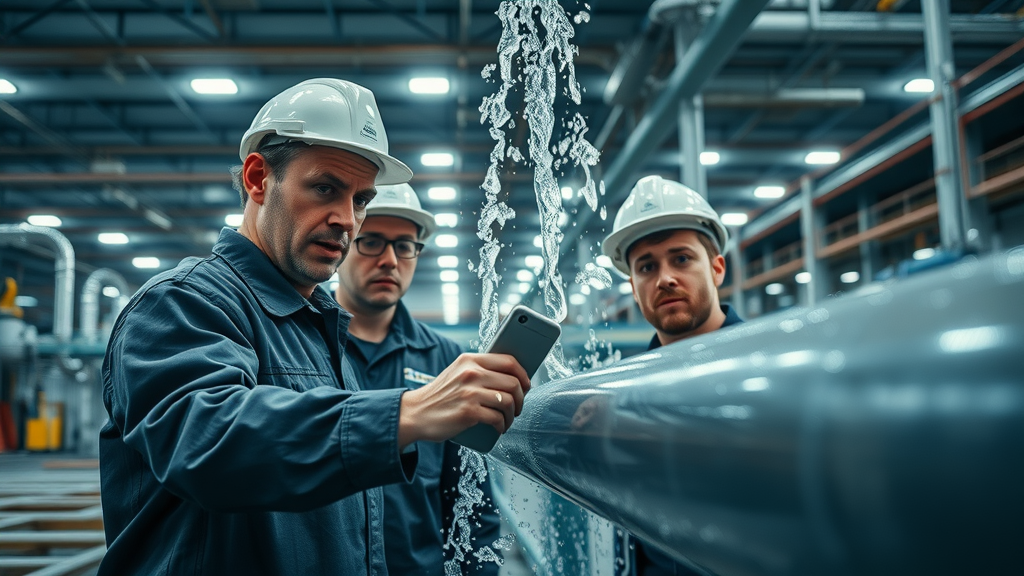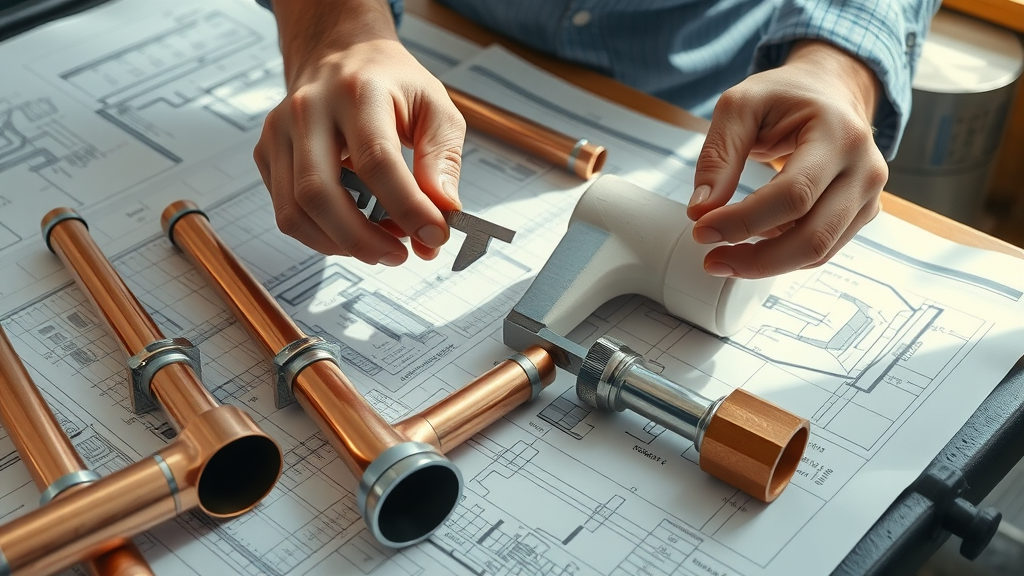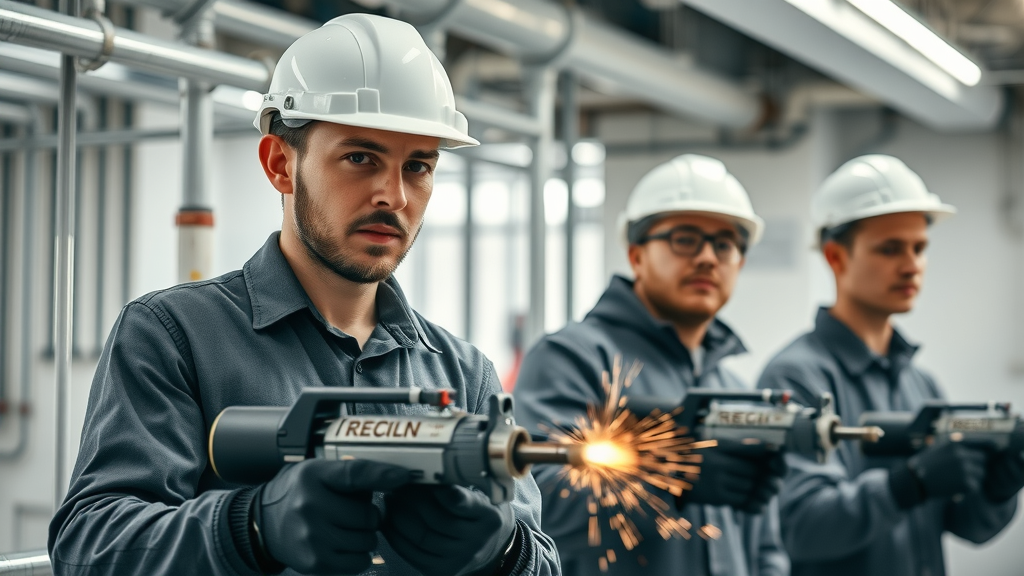Did you know a single pipe failure in an industrial building can result in losses exceeding £100,000—often in just a matter of hours? If you’re preparing for a commercial pipe installation, this astonishing figure highlights why getting it right matters so much. From differentiating commercial and industrial pipework systems to optimising costs and compliance, this comprehensive guide walks you through industry trends, practical solutions, and vital tips for your next project. Read on to ensure your investment is protected and your business stays ahead.
Exploring the Distinctions in Commercial Pipe Installation: Surprising Industry Trends
-
Discover how a single pipe failure can result in losses exceeding £100,000 in a typical industrial scenario. Learn what this means for your next commercial pipe installation.

The commercial pipe installation landscape is rapidly evolving, shaped by both market demands and advanced technologies. One of the most startling trends is the increasing complexity of work installations in commercial and industrial settings. As businesses expand and regulations tighten, the cost of downtime and repairs escalates sharply—making expert pipework services indispensable for any robust infrastructure.
With a wide range of supply pipe materials available, commercial and industrial pipework must meet tough standards for durability and compliance. Today, skilled engineers, pipe fitters, and gas engineers must work closely together to ensure every aspect of the pipeline—whether for heating, cooling, or waste—is integrated seamlessly. A single point failure, especially in systems like industrial pipework or supply pipe, can lead to massive disruption. That’s why modern pipework installations are more than a construction activity; they're a strategic investment in business continuity.
Essential Elements of Commercial Pipe Installation
-
Understand the unique requirements of commercial and industrial pipework, including planning, standards, quality controls, and regulatory compliance specific to commercial pipe installation.
Every commercial pipe installation begins not with tools, but with careful design, collaboration, and planning. Regulatory requirements for commercial and industrial pipework installations—especially in the UK—mandate strict adherence to standards such as BS EN 12056 for gravity drainage systems and WRAS for water supply pipe systems. Health and safety considerations demand robust risk assessments, while quality assurance systems ensure that materials, connections, and integration with mechanical services meet both client and regulatory expectations.
Quality control isn't just about compliance—it's about operational excellence. The installation services include regular site inspections, verification of pipe support, insulation checks, and confirming that every aspect of the pipework services aligns with the industry’s best practices. Skilled engineers and experienced teams help reduce the likelihood of costly work installations failures and boost long-term value for the business.
Commercial Pipework Installation vs. Industrial Pipework Installation
-
Contrast the specifications, applications, and regulations governing both commercial and industrial pipe installation.
While commercial pipework installation primarily serves office buildings, schools, and healthcare facilities, industrial pipework is designed to handle higher pressures and hazardous materials typically found in factories, plants, or energy facilities. The specifications for industrial and commercial work installations differ not just in pipe size or strength, but also in risk containment, temperature range, and regulatory oversight. For example, supply pipe in a commercial space prioritises reliability for daily usage, while industrial pipe and supply pipe must handle chemicals, vapor, or even high-pressure steam.
Compliance standards also differ: commercial systems must meet building and fire codes, while industrial installations require adherence to more stringent regulations such as the Pressure Systems Safety Regulations (PSSR) and the UK Gas Safety (Installations and Use) Regulations. These distinctions make the choice of materials, layouts, and installation services even more critical in achieving a safe, long-lasting, and efficient pipework installation.
Materials & Pipework Installation Options for Commercial and Industrial Projects
-
Explore the most common materials used, such as copper, steel, and plastic, and how their selection impacts the longevity and performance of your commercial pipe installation.

The choice of material in commercial and industrial pipework projects can make the difference between system longevity and premature failure. Copper remains a staple in commercial pipework installation thanks to its corrosion resistance, ease of soldering, and compatibility with both hot and cold supply pipe systems. Steel, especially stainless and galvanised varieties, is a go-to option for industrial pipework due to its high pressure and temperature tolerance—vital in specialised mechanical services and heavy industrial settings.
For cost-efficiency and certain supply pipe runs, high-grade plastic options like CPVC and PEX are becoming increasingly popular, especially for retrofits or in non-pressurised environments. Their lightweight design cuts installation time and reduces the need for extensive support brackets. However, they may lack the resilience of metal options in demanding work installations. A skilled team of pipe fitters and gas engineers is essential to match pipework materials with the project’s requirements and long-term performance goals.
If you’re interested in a deeper dive into advanced techniques and material selection for complex projects, you may find the guide on advanced pipe installation for commercial projects especially useful. It covers innovative approaches and best practices that can further enhance the reliability and efficiency of your installation.
Choosing the Right Industrial Pipe and Supply Pipe
-
Analyse the factors – pressure, usage, compatibility – that guide the choice in industrial and commercial pipework.
Selecting the right industrial pipe or supply pipe means considering pressure rating, thermal expansion, chemical compatibility, and overall lifecycle cost. In commercial installations, pipes are chosen to withstand regular usage cycles and moderate temperature or pressure swings. In industrial environments, focus shifts to resilience against corrosive substances, intense heat, and fluctuating loads. A thorough assessment by experienced teams and a mechanical services specialist ensures the chosen pipework systems deliver not only compliance but also maximum operational uptime.
Both commercial and industrial pipework installations often require bespoke solutions—sometimes combining different materials or joining methods to create a hybrid system that balances budget, compliance, and durability. Engaging a specialist in pipework services early in the design phase streamlines installation, reduces maintenance demands, and helps future-proof your investment.
Feature Comparison Table: Commercial vs. Industrial Pipe Installation
|
Feature |
Commercial Pipe Installation |
Industrial Pipe Installation |
|---|---|---|
|
Common Materials |
Copper, CPVC, PEX, Mild Steel |
Stainless Steel, Galvanised Steel, HDPE |
|
Durability |
10–25 years (average) |
20–50+ years (with maintenance) |
|
Cost |
Moderate to High |
High (due to material and compliance) |
|
Compliance |
Building & Fire Codes, WRAS |
PSSR, COMAH, Industry-Specific |
|
Applications |
Offices, Retail, Multi-Use Buildings |
Energy, Manufacturing, Processing |
Process & Steps for Successful Pipework Installation Services
-
Step-by-step breakdown of the stages: designing pipe runs, mechanical services integration, safety protocols, and sign-off for commercial pipe installation.

Effective pipework installation services follow a structured process that eliminates guesswork and supports safety at every step. The journey begins with designing pipe runs—mapping out precision routes for each supply pipe, taking into account existing structures and the requirements of building occupants. Integration with mechanical services like HVAC and fire suppression systems optimises efficiency and space usage.
Pipework installation hinges on experienced teams and health and safety discipline. After the design phase, skilled pipe fitters coordinate with other trades to install, connect, and support each length of pipe. Quality checks throughout ensure alignment, leak tightness, and code conformity—supported by rigorous mechanical services inspection before handover.
Key Compliance and Safety Considerations in Commercial and Industrial Pipe Installation
-
Critical compliance with UK standards and best practices for safe and efficient work installations.
Compliance in commercial and industrial pipework covers more than just paperwork—it's a methodical approach underpinning every decision, from pipe selection to installation services. UK law requires adherence to detailed standards (such as BS EN, PED, and WRAS) with frequent inspections and comprehensive documentation of every work installation.
Safety protocols protect not just property, but personnel—ensuring pipework installation processes account for safe working conditions, emergency shut-offs, and regular risk assessments. Health and safety commitments from both client and installer are essential for successful, issue-free projects, and reduce the risk of legal or insurance complications down the line.
Expert Insights: Streamlining Commercial Pipework Installation
“A poorly installed system can multiply costs over time. Sourcing experienced pipework services is the single most important decision you’ll make for your business infrastructure.”
– Senior Project Engineer, UK Commercial Pipe Firm
-
Highlight expert strategies for reducing downtime and improving productivity in commercial and industrial pipework projects.

Streamlining commercial pipework installation is all about leveraging expertise, advanced scheduling, and digital project tracking to reduce disruption. Leading work services providers use 3D modelling software and prefabrication techniques to cut on-site build time and anticipate logistical issues before they arise. This coordinated approach significantly minimises disruption to ongoing operations and enhances the reliability of internal supply pipe systems.
Productivity improves when installation services include cross-trained teams that can adapt to new regulatory requirements and integrate various mechanical services efficiently. Trusted firms maintain a strong network of team of skilled engineers and project managers who continually monitor progress against benchmarks, ensuring your commercial and industrial pipework installations are both fast and fault-free.
Cost Factors in Commercial Pipe Installation—What Affects Your Budget
-
Explore typical commercial pipe installation pricing models, what drives up costs, and tips to maximise your ROI through insightful work services.

The cost of commercial pipe installation varies widely depending on building size, pipework system complexity, choice of supply pipe and industrial pipe, labour, and local compliance requirements. Key drivers include access limitations, integration challenges with legacy mechanical services, and the need for out-of-hours work installations to avoid business interruption. A complete pipe installation quote should account for all materials, labour, and contingency.
Maximising your return on investment in pipework installation services means not only scrutinising direct costs, but also evaluating post-installation value—how easy the system is to maintain, and how likely it is to prevent future downtime. Working with an experienced team and seeking references for recent commercial and industrial pipework projects will help you gauge both cost and future savings.
-
Five Ways to Optimise Value on Your Next Commercial Pipe Installation:
-
Request detailed, itemised quotes covering all aspects of pipework installation and follow-up care;
-
Engage experienced, accredited pipe fitters and skilled engineers for project delivery;
-
Specify durable, compliant materials for your industrial and commercial pipe systems;
-
Build in periodic maintenance with your installation services to minimise lifetime costs;
-
Leverage digital project tracking for real-time budget and work installations monitoring.
-
Commercial Pipework Installation Services: What to Expect
-
Comprehensive overview of installation services offered: design, fabrication, maintenance, mechanical services and emergency repairs.
When you contract for commercial pipework installation services , expect a seamless process starting with site surveys and 3D system design. Services include detailed fabrication off-site, expert installation by a team of skilled engineers, integration of mechanical services, and post-installation testing. Professional firms ensure all work installations are documented for compliance and support tailored maintenance programmes—including emergency repairs for critical incidents.
Your provider's services include not only basic installation, but also ongoing inspection, diagnostics, and advice on energy efficiency upgrades. By working closely with your installation partner, you secure long-term performance and regulatory peace of mind for your supply pipe, industrial pipe, and commercial pipework.
People Also Ask: Answers to Common Commercial Pipe Installation Questions
Which is the most commonly used pipework system in commercial heating installations?
-
Steel and copper remain the dominant choices for commercial heating pipework installation due to their durability and widespread compatibility with mechanical services.
In commercial environments, steel and copper are most frequently selected for heating installations. Their resilience, excellent thermal transfer capabilities, and extensive history of safe performance make them the foundation of modern commercial pipework. Both pipe types are equally suited for integration with mechanical services, found in offices as well as healthcare and educational facilities.
What kind of pipe is used in commercial buildings?
-
Commercial pipe installations commonly feature copper, CPVC, PEX, and occasionally stainless steel—balancing cost, efficiency, and longevity.
The typical supply pipe in commercial settings is made from copper, CPVC, or PEX, with stainless steel reserved for demanding or visible applications. These materials are proven for hot and cold water delivery, waste removal, and HVAC. The choice is shaped by regulatory needs and the specific demands of the work installations required in each commercial project.
What is the process of installing water pipes?
-
Typical supply pipe installation includes system design, material selection, trenching or wall mounting, mechanical fitting, testing, and final commissioning.
Water pipe installation in a commercial setting is a carefully staged process. It starts with a detailed system design, factoring in pressure, flow, and mechanical services integration. After selecting suitable supply pipe materials, the team undertakes either trenching (for buried pipes) or wall/ceiling mounting, followed by mechanical connection and leak testing before the system is commissioned and signed off.
What size pipe is a commercial water main?
-
Commercial water main pipes typically range from 50mm to over 150mm in diameter, with size tailored to property demand and regulatory compliance.
Most commercial water mains use pipes sized between 50mm and 150mm. The correct pipe size is determined by calculating the property’s expected peak water demand, the length of supply runs, and compliance with the UK's water regulation standards. Under-sizing risks inadequate supply and over-pressuring, while over-sizing can result in increased costs and difficulties integrating with commercial pipework systems.
Frequently Asked Questions on Commercial Pipe Installation
-
Address top queries on timelines, permits, warranty options, and tailored maintenance programmes for commercial and industrial pipework.
How long does a typical commercial pipework installation take? While project times range from several days for small supply pipe upgrades to several weeks for full building pipework installations, timelines depend on building size, access, and scope.
Do I need a permit for work installations? Yes, most commercial and industrial pipework projects in the UK require permits for water, gas, and drainage connections. Your installation services provider can assist with all compliance paperwork.
What warranties are available? Leading pipework services offer warranties on both materials (typically 5–15 years) and installation workmanship, with optional maintenance plans to ensure prolonged system life.
Are ongoing maintenance services included? Many providers offer tailored inspection and maintenance programmes for industrial pipe and supply pipe runs—preventing faults and optimising compliance.
Crucial Points to Remember for Your Next Pipework Installation
-
Verify contractor experience with commercial and industrial pipework
-
Prioritise UK regulation compliance in all work installations
-
Clarify warranties for both industrial pipe and supply pipe
-
Request detailed installation service quotes and references
-
Schedule regular pipework services to minimise future repairs
Let Us Help with Your Commercial Pipe Installation Project
-
If you would like us to interview you as a subject expert for your business or organisation, email ai@dylbo.com
Take proactive steps—work with proven experts, plan every supply pipe run, and prioritise quality for a safer, more efficient commercial pipe installation.
If you’re looking to expand your knowledge beyond the fundamentals, exploring advanced strategies can help you future-proof your next project. For a broader perspective on innovative installation methods, project management, and the latest industry advancements, visit our comprehensive resource on advanced pipe installation for commercial projects . This guide offers actionable insights and next-level techniques to help you achieve superior results and long-term value in your commercial plumbing investments.
Sources
When planning a commercial pipe installation, it’s essential to understand the process and best practices to ensure a successful project. The article “What to Expect During a Commercial Plumbing Installation” provides a comprehensive overview of the stages involved, from initial design and code compliance to pipe installation and system testing. This resource offers valuable insights into the complexities of commercial plumbing projects. ( atowncpm.com )
Additionally, “Pipe-Joining 101: Commercial Plumbing, Heating and Air Systems, Part 1” delves into various pipe-joining methods, such as grooved joints and welding techniques, highlighting their advantages and considerations. Understanding these methods is crucial for selecting the appropriate joining technique for your specific installation needs. ( phcppros.com )
If you’re serious about ensuring the success of your commercial pipe installation, these resources will provide you with the knowledge and guidance necessary to make informed decisions throughout the process.
 Add Row
Add Row  Add
Add 










 Add Row
Add Row  Add
Add 

Write A Comment